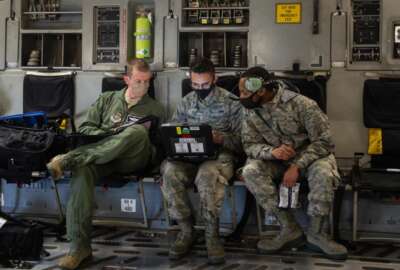
Hubbard Radio Washington DC, LLC. All rights reserved. This website is not intended for users located within the European Economic Area.
Hubbard Radio Washington DC, LLC. All rights reserved. This website is not intended for users located within the European Economic Area.
Lauren Knausenberger, the Air Force’s chief information officer, said despite protest delays, the service is taking steps to prepare for the future enterprise...
Lauren Knausenberger, the Air Force’s chief information officer, hedged her bets back in early December about when the service’s enterprise-IT-as-a-service (EITaaS) would get off the ground.
“My money is on January to be able to move forward with an award. But I understand that there could be a second round of protests that put us into April,” Knausenberger said after speaking at the AFCEA Nova Air Force IT Day. “That’s just how the process works. I do think that it will be January or April, but I’m going to leave it to our acquisition professionals and our lawyers to do the right thing.”
Turns out Knausenberger read the tea leaves well, as two of the unsuccessful bidders for the 10-year, $5.7 billion EITaaS contract filed a second round of protests on Jan. 3.
Peraton and Accenture Federal Services claim Air Force’s corrective action after their initial protests of the award to CACI fell short. CACI won the Wave 1 contract in August to provide IT service management, end user devices and various support services, including operating a centralized helpdesk for the Air Force and Space Force.
Both Peraton and Accenture Federal Services declined to comment on their second set of protests.
But Federal News Network has learned Peraton and Accenture both allege in their protests that:
The Government Accountability Office has until April 13 to decide the case, assuming the Air Force doesn’t again take corrective action or the vendors withdraw their protests.
The Air Force and CACI didn’t immediately return requests for comments.
Peraton, Accenture Federal Services and SAIC protested the Air Force’s first award to CACI in September. GAO dismissed the protest when the Air Force said it would take corrective action shortly after the companies filed the protests.
Federal News Network has learned that the Air Force told GAO that its correction action would include investigating the alleged conflicts based on claims that they resulted in an unfair competitive advantage for CACI. The Air Force also would reevaluate all of the proposals with regard to the competitors’ prior experience and make a new best-value tradeoff and award determination.
The Air Force, once again, awarded the contract to CACI in late December, leading to Peraton and Accenture filing a second protest. SAIC did not file a protest with GAO.
Whether or not Knausenberger’s prediction comes to fruition with an April kick off, the Air Force is moving toward EITaaS and is preparing in other ways beyond the basic contract.

She said the Air Force is looking at some of the underlying efforts that will support EITaaS, like the IT service management platform, workflow processes and enterprise license agreements.
“How do we look at our processes end-to-end? What are the services that we want to go into it as wave one? How do we communicate that to the workforce? What does affect our current workforce and what does not? And then also, what are the things that we have to do to prepare? And that’s something where the Air Combat Command is the lead command or the Cyberspace Capabilities Center or our program executive office up in Boston, they’re looking at the very fine details of how do we execute this starting on day one,” Knausenberger said. “I know that our prime vendors are also going back through the proposal, the transition plan and taking advantage of the extra time to really make sure that they can hit the ground running.”
Few expected the Air Force’s plan to outsource the day-to-day management of its technology network and devices to go smoothly. Like previous attempts, whether by the Department of Navy with the Navy-Marines Corps Intranet (NMCI) or the Army’s decision not to proceed with its version of the EITaaS, these programs come with a boat load of questions and challenges.
The Air Force tried to address several of those questions with a pilot of EITaaS through an other transaction agreement. Accenture Federal Services was one of four vendors chosen under the OTA. AFS provided compute and store services to six bases including Maxwell in Alabama, Offutt in Nebraska and Joint Base Elmendorf-Richardson in Alaska.
But as with any large, long-term contract like EITaaS, losing rarely goes down easy for unsuccessful bidders.
The good news is the Air Force recognizes it needs more than one vendor, unlike NMCI had in the late 1990s-early 2000s. Knausenberger said Wave 2 will be multi-award with a goal of bringing all the services together from Waves 1 and 2.
“With Wave 1, even though we [will] have one prime, there is a lot of content there for small business, I want to say north of 40% for small business. The way that we’ve structured it, it’s such that no one business has all of the skill sets that we need for that work, so a successful prime would be a prime that finds the best of all of those services in the market, and brings them together in a seamless way,” she said.
While the future of EITaaS remains a bit murky, Knausenberger’s plate remains full with assorted other initiatives.
One big initiative is consolidating and better managing enterprise licenses for cloud and software as a services like ServiceNow, VMWare and Salesforce, for example.
“With a lot of our large enterprise licenses, we’ve recognized that we have multiple licenses. So I’m going to just make up a use case, let’s say with ServiceNow, that we have 40 different contracts and that we’re spending X millions of dollars. In a lot of cases, the vendors come to us and say, ‘Hey, do you guys know how much you’re spending with us? It’s X millions of dollars and we have 40 different contracts, and we think that we could actually do an enterprise deal with you for the same price, or for only this small amount more, we could do an enterprise deal and anybody new that comes in can get this capability,” Knausenberger said. “It is a win-win for us and for the vendor if we can take a look at our whole spend and if we can figure this out instead of doing this 40 times where we have to issue 40 contracts and they have to manage 40 contracts with different capability sets across the 40 contracts. We can do it once for the enterprise. And then instead of paying separately, we just have lines that go to whatever mission area is using it.”
Knausenberger said this will make it easier for folks to use the SaaS in the future because they will know it’s accredited and ready to use.
Another priority is application rationalization to consolidate the hundreds of applications in each portfolio. She said each portfolio are in a multi-year journey to upgrade, replace, consolidate and/or move to the cloud. The Air Force has shut down hundreds of applications in the last few years.
Knausenberger said other priorities include improving Air Operations Center’s bandwidth and resiliency as well as roll out enterprise identity and access management services.
“We have a software-defined wide area network (SD-WAN) decision coming up in February. We have data mesh and compute pilot going on in the Pacific with all of those things converging around June. I see that June pilot as a capstone for all of the things that we are doing in that digital space,” she said. “Meanwhile, we are really getting the ducks in a row for IT portfolio management, rolling out EITaaS Wave 1. We are making sure that our zero trust strategy is just really, really tight as we move into fiscal 2024.”
Copyright © 2024 Federal News Network. All rights reserved. This website is not intended for users located within the European Economic Area.
Jason Miller is executive editor of Federal News Network and directs news coverage on the people, policy and programs of the federal government.
Follow @jmillerWFED

